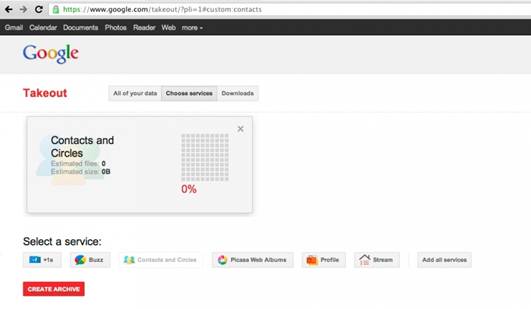Completing Your Escape
Takeout will create a local copy of your
personal information and data files. However, this information will still
reside on Google’s servers. To complete a full ‘escape’ from a Google product
or service, some additional steps are required. Steps that aren’t part of the
Takeout service.
Removing data from Google’s servers is a
manual process, one that has to be done by visiting each product or service in
turn. Unfortunately, as the steps involved can vary considerably, it could end
up being quite a lengthy learning curve. Realizing this dilemma the DLF team have
provided a set of step by step ‘escape’ instructions on their website for a
long list of products and services (see box out).

Takeout
will create a local copy of your personal information and data files
So, all you’ll need to do is follow these step
by step instructions and your personal data will be erased forever. Right?
Actually, not quite. Information might well still exist on backup servers and
associated archive repositories. Over time this archive might be removed, but
how long this will take, and how much information is destined to always remain,
isn’t clear. With personal data being such a goldmine for Google and every
other web savvy company - the complete removal of every single piece of it
might just be an impossible dream.
A Good Start, But
While it’s great news that these DLF
services exist, there’s still room for improvement.
For example, as yet not every Google
product is covered by DLF’s facilities. Information posted on their website
suggests they are around two thirds of the way through, but with so many Google
products and services there is plenty left to do. And Google is highly likely
to introduce new initiatives in the meantime.
One of the biggest omissions is search
history. Of course, it might be on DLF’s to-do list; or it just might be a
little too sensitive to expose. You can access Voice data, yet for some reason
Chat isn’t currently part of the service. And there’s no way to access YouTube
information, such as uploaded, shared and liked videos. Support for Blogger
posts and comments would be welcomed by many users, myself included, as would
the ability to download Calendar entries and tasks.
And what about Google Android data? The
typical smartphone holds an enormous amount for personal information: contacts,
calendar entries, photos, app downloads, web activity and geo-location logs,
plus the account details necessary to access email, social, commerce and
banking services. This list might soon be supplemented by handset-based
purchasing services, such as Google Wallet and Checkout.

what
about Google Android data?
A downloadable DLF app that’s able to
‘clean-up’ the smartphone’s local storage (maybe backing up this information
onto a PC or memory card first) would be useful. However, much of this data
will have already been synchronized to Google’s cloud-based servers. So, a
similar set of Takeout tools and ‘escape’ instructions would be needed to cater
for any Android-specific information.
Applying Pressure
The technology developed by the DLF team
may help Google’s public image, and go some way towards pacifying those who say
its ‘Don’t Do Evil’ motto has been forgotten in a headlong rush to complete
with the likes of Apple and Facebook. Yet, if this is their intention, why
don’t Google publicize the DLF work more prominently? And why is it taking so
long to support some key products? There’s no engineering reason why this
cannot be done, DLF team have the knowledge at their disposal. They could, for
instance, ensure Takeout capabilities are accessible from the ‘Settings’ menu in
every product and service.
Will Facebook, Apple or Amazon do something
similar? I’d tend to think it’s unlikely to happen, at least until tougher
privacy legislation pushes them down this path. However, if Google was to
promote personal data access and transparency much more heavily - say, by
implicit integration – it would put pressure on others to at least attempt
something similar.
Maybe we can change things, too. We could
utilize the power of the blog sphere and social media channels to put pressure
on these organizations to open up their information vaults. After all, it is
our data, isn’t it?
|
How- To Escape Product List
·
AdWords
·
Alerts
·
Analytics
·
App Engine
·
Apps for Business
·
Blogger
·
Bookmarks
·
Calendar
·
Chrome Bookmarks
·
Finance
·
Gmail
·
Google Storage for Developers
·
GTalk Chats
·
Health
·
Latitude
·
Maps
·
Notebook
·
Orkut
·
Project Hosting
·
Reader
·
Sites
·
Talk
·
Web History
·
YouTube
|